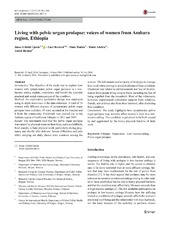| dc.contributor.author | Gjerde, Janne Lillelid | en_US |
| dc.contributor.author | Rørtveit, Guri | en_US |
| dc.contributor.author | Muleta, Mulu | en_US |
| dc.contributor.author | Adefris, Mulat | en_US |
| dc.contributor.author | Blystad, Astrid | en_US |
| dc.date.accessioned | 2017-06-12T11:11:29Z | |
| dc.date.available | 2017-06-12T11:11:29Z | |
| dc.date.issued | 2017-03 | |
| dc.Published | Gjerde JL, Rørtveit G, Muleta M, Adefris M, Blystad A. Living with pelvic organ prolapse: voices of women from Amhara region, Ethiopia. International Urogynecology Journal. 2017;28(3):361-366 | eng |
| dc.identifier.issn | 0937-3462 | |
| dc.identifier.uri | https://hdl.handle.net/1956/15963 | |
| dc.description.abstract | Introduction: The objective of the study was to explore how women with symptomatic pelvic organ prolapse in a lowincome setting explain, experience, and handle the potential practical and social consequences of the condition. Methods: An explorative qualitative design was employed using in-depth interviews in the data collection. A total of 24 women with different degrees of symptomatic pelvic organ prolapse were included; 18 were recruited at the hospital and 6 from the community. Fieldwork was carried out in the Amhara region of northwest Ethiopia in 2011 and 2015. Results: The informants held that the pelvic organ prolapse was caused by physical strain on their body, such as childbirth, food scarcity or hard physical work, particularly during pregnancy and shortly after delivery. Severe difficulties and pain while carrying out daily chores were common among the women. The informants used a variety of strategies to manage their work while striving to avoid disclosure of their condition. Disclosure was related to embarrassment and fear of discrimination from people living close to them, including the fear of being expelled from the household. Most of the informants, however, experienced substantial support from relatives, friends, and at times also from their husband, after disclosing their condition. Conclusions: The study highlights how symptomatic pelvic organ prolapse may severely affect women’s lives in a lowincome setting. The condition is perceived to be both caused by and aggravated by the heavy physical burdens of daily work. | en_US |
| dc.language.iso | eng | eng |
| dc.publisher | Springer | eng |
| dc.relation.ispartof | <a href="http://hdl.handle.net/1956/18651" target="blank"> Chronic disease among women in a resource-constrained setting. The case of pelvic organ prolapse in rural Ethiopia</a> | |
| dc.rights | Attribution CC BY | eng |
| dc.rights.uri | http://creativecommons.org/licenses/by/4.0 | eng |
| dc.subject | Ethiopia | eng |
| dc.subject | Experience | eng |
| dc.subject | Low-income setting | eng |
| dc.subject | Pelvic organ prolapse | eng |
| dc.title | Living with pelvic organ prolapse: voices of women from Amhara region, Ethiopia | en_US |
| dc.type | Peer reviewed | |
| dc.type | Journal article | |
| dc.date.updated | 2017-05-09T07:27:07Z | |
| dc.description.version | publishedVersion | en_US |
| dc.rights.holder | Copyright 2016 The Author(s) | |
| dc.identifier.doi | https://doi.org/10.1007/s00192-016-3077-6 | |
| dc.identifier.cristin | 1383904 | |
| dc.source.journal | International Urogynecology Journal | |

